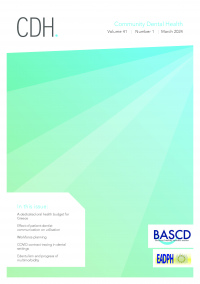March 2016
A review of daycase GA services for Special Care patients at University Hospital, Bristol
Abstract
This paper describes and discusses a review of adult special care dentistry day cases in a UK hospital over a two year period and makes recommendations for other such reviews and for practice. Dental public health competencies illustrated: oral health needs assessment and evaluation of dental health services. Key words: general anesthesia, special care, complex medical needs, hospital, United Kingdom Background Aim This review aimed to study the types and complexity of Special Care patients treated under GA at University Hospital, Bristol, UK, and the referral pathways by which they access the service. Service provision reviews such as these allow trusts to evaluate the need for such services in a hospital setting, and provide important information for commissioning of services and for workforce planning. Method From retrospective data available for patients seen between April 2011 and April 2013 on Special Care GA lists at University Hospital, Bristol, the following data were collected about each patient: age, referrer, special care needs of the patient, ASA physical status classification, capacity to consent for proposed treatment under the Mental Capacity Act 2005 (UK Government, 2005), reasonable adjustments made, treatment provided under anaesthetic, ongoing care provider and follow up plan. Analyses were descriptive. The 82 patients in this study were referred to the hospital Special Care service by the following primary care providers: 71% Committee (58) from thefor Community DentalDentistry, SA Specialist Advisory Special Care Service; 22% (18) by General Dental Practitioners; 7% curriculum: special care dentistry. London: SACSCD, Fa (6) by other professionals who had identified that these RCS(England). patients did not have access to routine dental care (4 UK Government (2005): The Mental Capacity Act. London: from General Medical Practitioners and 2 from specialist centres). Those patients’ ages ranged between 16 and 81years with the greatest number (39%) being in the 16 to 25 year old category (Figure 1). Number of patients Age group, years Special Care Dentistry seeks to address the oral health needs of people with a range of conditions which may result in their oral health being compromised either directly through the condition itself, or indirectly due to barriers to accessing care. Access to care may also be limited due to practitioners being unwilling or unable to provide routine dental care because of the lack of skills, experience, facilities or remuneration available to them (Fiske, 2006). There are a limited number of services where staff have the skills and expertise to manage Special Care patients with complex medical needs, behavioural challenges and consent issues who require treatment under general anaesthesia (GA). Results 16-25 26-35 36-45 46-55 56-65 66-75 >75 32 13 12 14 6 4 1 Figure 1. Age distribution of patients referred to the special Figure 1. Age distribution of patients referred to the special care d care department Regarding the medical complexity of the patients treated under GA, 89% were graded as 2 or above on the American Society of Anesthesiologists classification system (ASA, 2014) (Figure 2). This grade includes ASA category descriptor: Number of patients or those withand systemic disease potentially modifying complicating the anaesthetic plan, or dictating that the 1, normal healthy patient 9 risks of GA for the patient would outweigh the benefits of 44 2, patient with mildtreatment. systemic disease the proposed Of the patients seen, 83% were 3, patient severe systemic disease unablewith to themselves consent for their proposed treatment 29 under the Capacitydisease Act and required ‘best interest’ 4, patient withMental severe systemic 0 discussions regarding that is a constant threat to their life treatment options. Of the 82 patients, just 11 were of capable of consent the Act Figure 2. Distribution patients by ASAunder category and one required parental consent being aged under 18. Number of patients Correspondence to: Dr Shabnum Ali, School of Oral and Dental Sciences, Lower Maudlin Street, Bristol, BS1 2LY, UK. Email: shabnum. Extraction 71 [email protected] Restoration (Cons) 63 Scaling Blood Tests Implants Biopsy 39 16 1 1




